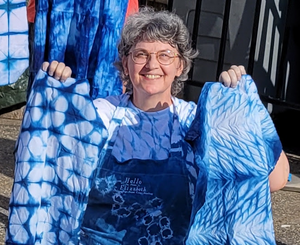Difference between revisions of "Projects: Indigo Shibori Dye"
| Line 54: | Line 54: | ||
Use 1 gallon of water for every 5 grams of dye. | Use 1 gallon of water for every 5 grams of dye. | ||
Instructions to check the vat (follow steps in this order!): | '''Instructions to check the vat''' (follow steps in this order!): | ||
# Test alkalinity: Vat should have pH of 10-12 -- if not, add more soda ash | # Test alkalinity: Vat should have pH of 10-12 -- if not, add more soda ash | ||
# Test reduction: Vat should be bright yellow-green with bronze bubbles on top. If not, add more reducing agent | # Test reduction: Vat should be bright yellow-green with bronze bubbles on top. If not, add more reducing agent | ||
Revision as of 13:16, 15 October 2021
Project by: Elizabeth Dalton
Overview
This page is to document some of the Indigo Dye Workshop information for reference for attendees and others interested in the process.
Event Name
Indigo Dye Workshop (Special Topics Monthly!)
Event Description
Indigo has been used to dye fabrics for at least 6000 years in civilizations all over the world. Indigo is derived from several species of plants and is non-toxic, colorfast, and sustainable. A single vat of indigo dye can be maintained for years and reused, simply adding new indigo and reducing agents as needed. Port City Maker Space maintains a shared indigo dye vat for use by members as well as other related equipment.
Please plan to attend at least one workshop before using the PCMS indigo dye vat.
We offer a workshop approximately once per month (usually on the first Sunday at 2pm) to provide an orientation to new dyers and to explore topics in indigo dying. Attendees learn how to check the dye vat, adjust ingredients as needed, and the basics of dyeing with indigo.
Each workshop also includes a session exploring a new topic. Topics are chosen based on input the previous month by workshop attendees and our Slack community. Previous topics have included Shibori-style pleating and binding and constructing dyed silk face masks. Future topics may include wax-resist (batik), yarn dyeing, designing quilting coordinates, reverse dyeing with color remover, over-dyeing with other dye types, and other topics suggested by participants. The cost of the workshop covers dye ingredients and materials for simple projects covered in the monthly topic and purchase of equipment for the Soft Craft space, with a nominal fee for the instructor's time. Workshop participants are also welcome to bring their own dyeing projects (one or two natural-fiber garments or equivalent weight).
Class Dates and Topics
- 9/4/2021 Intro to Indigo Shibori Fabric Dyeing
- 10/03/2021 Silk face mask (includes research, sewing and fitting)
- 11/14/2021 Wax resist (Batik) with Indigo Dye
- December TBD
Photo Album
A full photo album from the 9/4/2021 session can be found here:
Tutorials
Tutorials by the instructor:
Using the Indigo Dye vat
WEAR GLOVES AND MASK WHILE ADJUSTING VAT.
WEAR OLD CLOTHES AND SHOES WHILE WORKING WITH DYE.
If you want to use the indigo dye vat between classes, you will need to check it and possibly add ingredients. Some ingredients may be available at the shop with a "tip jar" to collect money to buy more, or you can bring your own. The three ingredients we use in our vat are:
- Indigo Order Indigo from Dharma Trading Co.
- Soda Ash (Sodium Carbonate) Order Soda Ash from Dharma Trading Co.
- Reducing Agent Thiourea Dioxide (also sold as Color Run Remover) or Sodium Hydrosulfite
Ratios: 1 part indigo dye : 2 parts Sodium Hydrosulfite : 4 parts Soda Ash
Use 1 gallon of water for every 5 grams of dye.
Instructions to check the vat (follow steps in this order!):
- Test alkalinity: Vat should have pH of 10-12 -- if not, add more soda ash
- Test reduction: Vat should be bright yellow-green with bronze bubbles on top. If not, add more reducing agent
- Test indigo strength: Test swatch should turn bright yellow-green after 5 minutes immersed, and should quickly darken to navy blue. If not, add more indigo powder.
Wait at least 15 minutes after each adjustment before re-testing or continuing to the next step.
Helpful Resources
Here are a few resources recommended by the instructor:
- DIY Shibori Extended tutorial covering itajime, arashi, kumo pleating and binding
- World Shibori Network Historical and cultural references
- Shibori Wikipedia article
- 5 Things You Should Know About Japanese Shibori Dyeing Historical reference listing traditional Japanese shibori techniques
- Dharma Trading Co. featured article Describes traditional Japanese pleating techniques Arashi, Kumo, Itajime
- envatoTuts+ Shibori for Beginners: Ne-maki Technique Binding around objects
- The Crucible Industrial Arts: Beginners Guide to Indigo Dyeing Describes different long-term indigo dye vats
